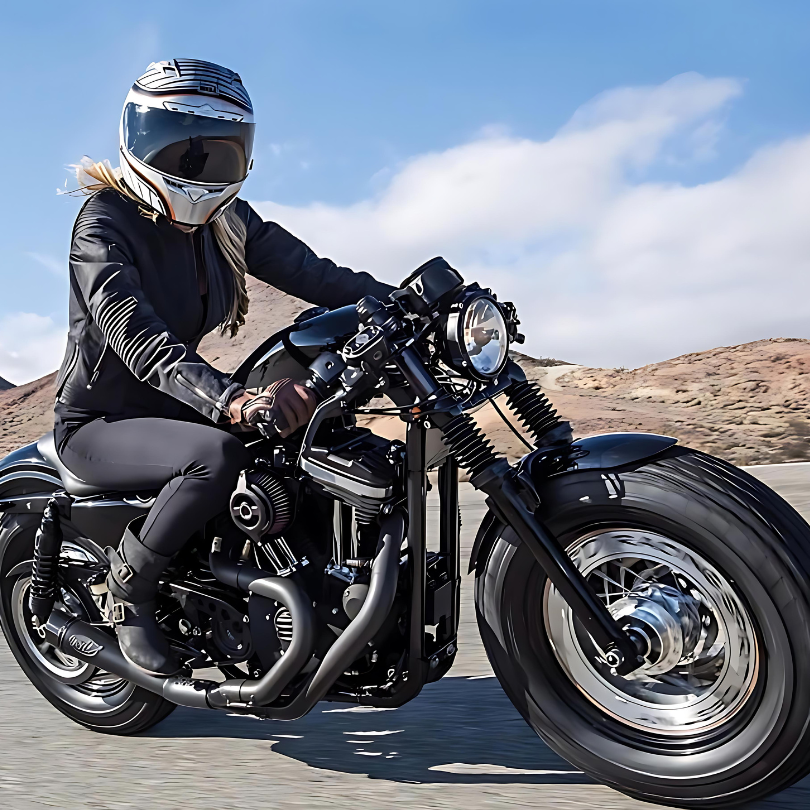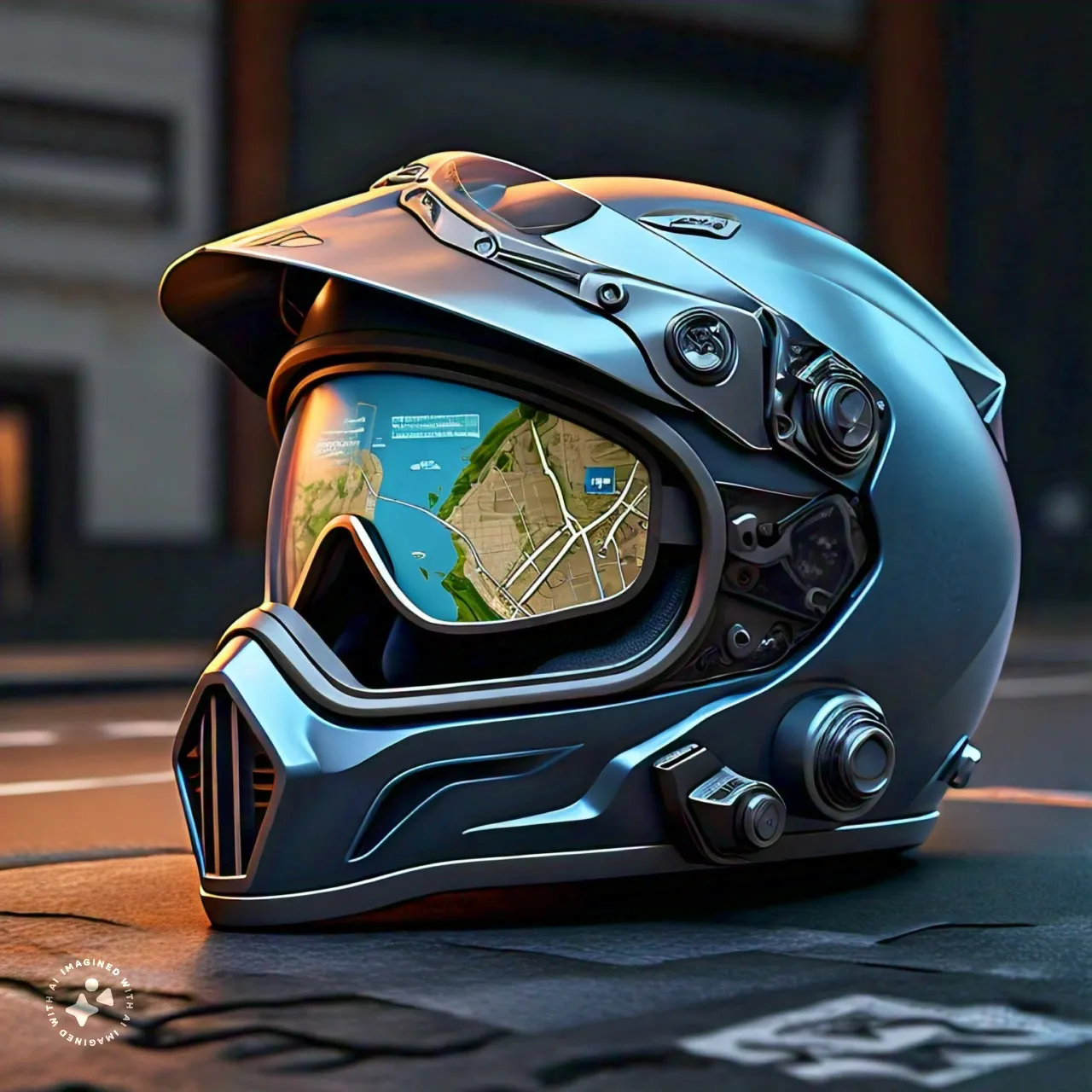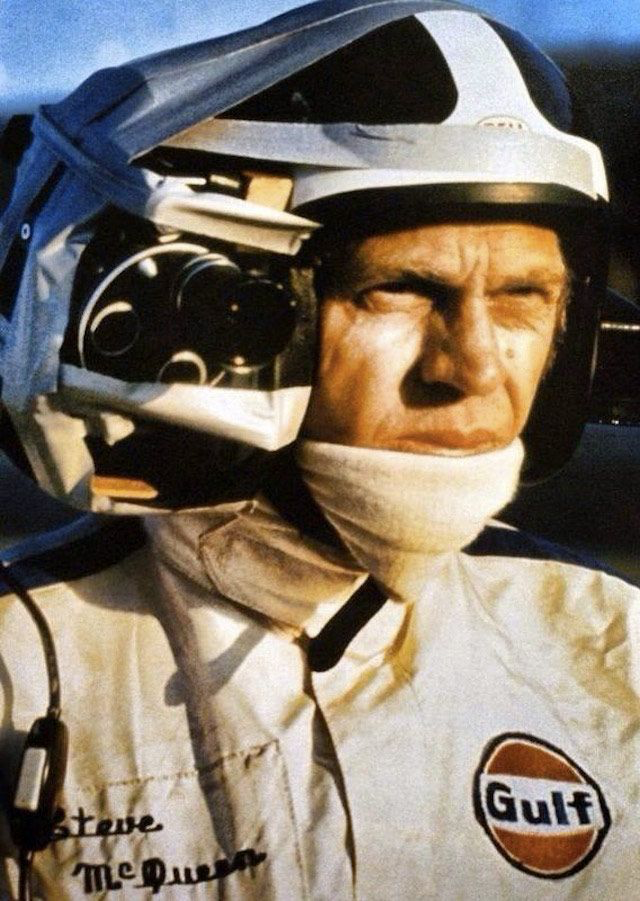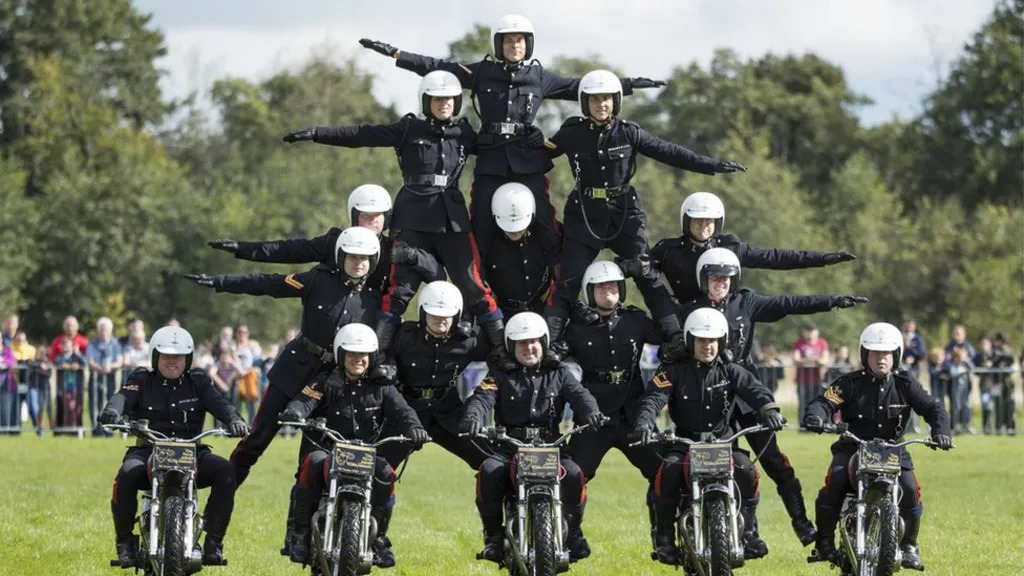10 Tips for Buying Your Motorcycle Helmet
I have a big head.
There may be nothing in it, but it's big.
My brother's head is even bigger! It's so big that somehow he even managed to close a car door on it.
True story.
I tried on his motorcycle helmet one time and it was huge. It was like wearing a toilet bowl on my head. Having said that, it's not easy for me to find a helmet that fits comfortably. I figured we could provide our top tips on choosing a helmet that fits.
Keep in mind that helmet sizes may vary between brands, so it's always best to try on different helmets and sizes to find the best fit for your head shape.
A well-fitted helmet should be snug but not uncomfortably tight. It should not move around easily on your head, and you shouldn't feel any pressure points or discomfort.

Photo Credit Jeremy Bishop Motorcycle Helmet
1. How to measure your head!
You've got to measure your head so you know what size you're looking for. Measure about one inch above your eyes and go around the largest part of your head. I recommend doing it a couple of times just to make sure your measurement is accurate. Once you have an idea of the size of your cranium use the manufacturer’s chart to see what size you need.
To measure your head for a motorcycle helmet, follow these steps:
A. Wrap a flexible measuring tape around the widest part of your head, which is usually about one inch above your eyebrows, just above your ears, and around the back of your head at the largest point.
B. Note the measurement in inches or centimetres, whichever you prefer.
C. Use a motorcycle helmet sizing chart from the manufacturer you're interested in to determine the appropriate helmet size based on your measurement.
Keep in mind that helmet sizes may vary between brands, so it's always best to try on different helmets and sizes to find the best fit for your head shape.
A well-fitted helmet should be snug but not uncomfortably tight. It should not move around easily on your head, and you shouldn't feel any pressure points or discomfort.
2. Decide on the model of helmet you want
Before you even begin your quest for a new motorcycle helmet or ‘skid lid’, you need to decide what type you're looking for.
Are you after a full-face helmet with a visor that opens and closes? A modular helmet which allows you to flip up the chin bar as well as the visor? An open face helmet, or a beanie helmet? Once you've settled on a few types of motorcycle helmets you want, you can narrow down your choices by trying the helmets on in real-life. Here’s what makes them different:
Full-Face Helmets provide the most face coverage, protecting the entire head and face with a chin bar. They're the safest type of helmet and offer excellent protection in case of an accident. Getting the right fit is super important but once that’s in place and your safety standard is selected, the differentiator is the amount of wind noise the helmet creates.
Modular Helmets are also known as flip-up helmets, they combine the features of full-face and open-face helmets. The chin bar can be flipped up, allowing for easier communication and ventilation because you can have a conversation with people with your helmet on! Like at the gas station. It’s also possible to have a drink or a bite to eat with your motorcycle helmet on! Depending on who you talk to, modular helmets can be less safe due to the construction of the flip-up chin bar and more expensive. Noted!
Open-Face Helmets are often called 3/4 helmets, and they cover the top, back, and sides of your head, but leave the face exposed. They provide less protection than full-face helmets, but offer good visibility and airflow. These motorcycle helmets allow bugs and small rocks to fly into your face, so not great if you’re doing highway riding or long motorcycle road trips. When you get caught in the rain, the open-face helmet sucks because rain drips into your jacket and down your back. Hate that.
Half Helmets are also called beanie helmets, shorty helmets or piss pots, they provide the least amount of coverage and protection, because they only cover the top of your head. Basically, they’re used to comply with helmet laws when you don’t want to comply. These helmets are not safe.

Photo credit Chicks On Motorcycles Tumblr
3. Pick the motorcycle helmet safety standard you want or need
In both the United States and Canada, the Department of Transportation (DOT) certification is the lowest standard required for motorcycle helmets. Helmets with higher standards of safety like SNELL or ECE certifications are obviously accepted too.
Your passenger also needs a certified helmet. You can check for the certification stickers on the helmet, as they indicate that the helmet meets the safety standards required by law.
I'll list the motorcycle helmet certifications in order from highest to lowest level, based on their testing standards and reputation for safety:
First off is Snell Memorial Foundation or SNELL it’s widely considered to have the most rigorous testing standards, Snell certification is highly respected and often sought after by riders.
Second is ECE 22.05 it’s a Europe standard for motorcycle helmets sold in the EU and UK, it was developed by the Economic Commission for Europe. This international standard is recognized in over 50 countries and emphasizes impact absorption, retention system effectiveness, and field of vision.
Third is SHARP, the Safety Helmet Assessment and Rating Programme, based in the UK. This standard uses a star rating system (5 stars being the highest) to evaluate helmets' safety performance.
Fourth and most common is the DOT Certification Motorcycle Helmet level of safety standard but it’s a low bar in safety. This standard is mostly sold in North America.
DOT is based on the FMVSS 218 standard, which involves tests for impact attenuation (reduction in strength of the helmet when dropped or in a crash), penetration resistance, and retention system strength. It relies on a self-certification model, so manufacturers test their helmets and declare compliance with the standards on their own. This is a self policing standard. Helmets are tested for two impacts in the same location and need to stay intact to pass.
Last but not least is the FIM or Fédération Internationale de Motocyclisme's Racing Homologation Programme for Helmets. This safety standard is primarily focused on racing helmets and not commonly seen in street-legal helmets.
4. Figure out your head shape
To ensure a proper fit, always try on different sizes and models helmets before making a purchase. A well-fitting helmet is crucial for safety and comfort while riding.
When you're at the dealership or accessory shop or biker gear store and staring at a wall of helmets it can be daunting, so make sure you set aside enough time to make the right choice. Don't take anyone with you that's not willing to spend time wandering around the shop while you work through your choices. Listening to "Are you almost done?" is not helpful when making such an important choice. Believe me, I know.
Each brand or manufacturer uses a different head shape. You'll find one brand fits you better than another. The sizing chart for each brand is different as well. Buying one online is possible but the right fit needs a try-on. Once you have a fit, you can switch to online!
Just buying one online and hoping for the best is a losing strategy. You want to get one that fits well and feels comfortable and clicking buy now isn't really going to give you the same information as actually putting one on your noggin and seeing how it feels.
If you decide to shop online after trying some on and finding one you like at a dealership then that's a different matter. The size you choose at the shop and the size you choose online should be the same thanks to consistent manufacturing processes. (I hope.)
Motorcycle helmets come in various shapes, each designed to fit different head shapes and offer unique benefits. Here's a list of the common helmet shapes:
Round Oval: These helmets are designed for riders with a round head shape, where the front-to-back and side-to-side measurements are nearly equal. They are symmetrical and provide a snug fit for those with this head shape.
Intermediate Oval: This is the most common helmet shape, fitting most riders. It's slightly longer from front to back than side to side, providing a comfortable fit for those with an average head shape. For example, Arai and Shoei helmets typically have an intermediate oval shape. However, they fit completely differently so it's essential to try different models of helmets, as some may have slight variations in their internal shape that may fit your head better than others.
Long Oval: These helmets are designed for riders with a long oval head shape, where the front-to-back measurement is significantly longer than the side-to-side measurement. They provide a snug fit for those with narrower heads.
Narrow Oval: Narrow oval helmets are designed for riders with narrower heads, providing a snug fit for those with this head shape. They are slightly less common than the other shapes.
5. Put the helmet on and walk around
Find a helmet you want to try, put it on, buckle it up and leave it on. Often you can tell immediately if the helmet isn't the right one for you. It could be way too tight or loose. A helmet can begin to feel pinchy and display pressure points after a while. I find the longer you can leave it on, the better. Red marks will indicate pressure points.

Pick your helmet and make it white
Before you go for a test walk, here’s how to put on the helmet. Just don't forget and walk out of the store with it. But if you've forgotten it's on your head, that's a good sign it's a good fit, I guess.
Here's how to properly put on a motorcycle helmet:
Step 1. Make sure your hair is secure and not in the way of the helmet's fit.
Step 2. Hold the helmet by the chin straps with both hands.
Step 3. Position the front of the helmet just above your eyebrows and tilt your head slightly forward.
Step 4. Gently slide the helmet down over your head, pulling the straps outwards as you do so.
Step 5. Make sure the helmet sits level on your head, covering your forehead and the back of your head.
Step 6. Adjust the chin strap so that it fits snugly under your chin. The strap should allow no more than one or two fingers to fit between the strap and your chin.
Step 7. Fasten the chin strap securely and check that the helmet does not move around when you move your head.
Step 8. Perform a final check by opening and closing your mouth. If the helmet feels snug and does not move, it's properly fitted.
6. Pick an integrated or snap on Bluetooth communications system
Helmets with integrated Bluetooth technology are all the rage but you can still go old-school for a communicator and get an after-market communication system. They offer several benefits for riders, like:
Hands-Free Communication: Bluetooth-enabled helmets have a communication device already installed in the helmet and connect to your smartphone. This makes it possible to make and receive phone calls, listen to music, and talk with other riders with a similar system without needing to take your hands off the handlebars. But, the disadvantage is that they cost more and you need to charge your helmet for each ride because the communicator doesn’t come out of the helmet.
Whether you go with an integrated or an after-market Bluetooth communication system here are a few benefits.
Enhanced Navigation: With Bluetooth connectivity, riders can hear the turn-by-turn directions directly in their helmet when connected to a smartphone or GPS device. This is really handy.
Improved Safety: By enabling hands-free communication and reducing distractions, Bluetooth communicators can help you maintain focus on the road and minimize the risk of accidents, unless you start fidgeting with the gadget while you ride.
Comfort and Convenience: Bluetooth helmets or after-market communicators come with speakers and microphone, allowing riders to have better audio and communicate without needing to wear additional headphones or earbuds. However, with wind noise at speed and the use of earplugs, audio can be tricky so do your research before you buy.
Connectivity Between Riders: Bluetooth technology allows riders to maintain a connection with other devices and riders over a certain distance making it possible to talk to other riders on group rides or long-distance trips. However, hooking up the system to other riders can be a huge headache and can take a bunch of time to set up. Beware that most communicators need the riders to have the same brand to communicate with each other. Sena is working on a new tech that allows riders with different types of communicators to communicate via the Sena technology. Worth checking out.
7. To Smart Helmet or not to Smart Helmet?
Smart helmet technologies are all the rage in the motorcycle helmets industry. Helmet manufacturers are integrating a range of intelligent functionalities, like rear-view cameras, collision detection systems, and heads-up displays (HUDs), to enhance the safety and convenience of their helmets.
HUDs offer additional information projection on the inside of the visor like speed and navigation instructions, right in the rider’s direct line of sight.
You may remember all the rage about the helmet company Skully which aimed to revolutionize motorcycle helmets and raised millions . They went bust when it was revealed the brothers and co-founders spent their R&D money on cocaine and prostitutes.

Motorcycle Smart Helmet
These systems are designed to alert riders of potential dangers, providing an added layer of protection but for now, few have passed certification for road use. Frankly, it’s hard to see the benefit of obstructing my view on an already small visor (especially when dark on in the rain) and who wants electronics embedded into their skull in the event of an accident? More work required here.
While smart motorcycle helmets offer benefits, there are also some potential disadvantages to consider:
Cost: Smart helmets are generally more expensive than traditional helmets due to their onboard technology and features.
Weight and Comfort: Modules and batteries can add double the weight to the helmet, causing discomfort and fatigue resulting in reduced safety!
Battery Life: Smart helmets rely on battery power for their features to function, so riders need to remember to charge their helmets regularly. A dead battery renders the features unusable.
Durability: Smart helmets have more components than traditional helmets, increasing the potential for technical issues or malfunctions, especially after exposure to harsh weather conditions or impacts.
Distractions: While smart helmets aim to reduce your distractions, the audio prompts and notifications are distracting or overwhelming, especially if you’re not accustomed to using such technology.
8. Pick your color, but make it white!
Looking good is important. You’ll find every kind of motorcycle helmet chic out there. Some brands like Bell will even customize your helmet for you.
But research provides evidence that white is the safest color for motorcycle helmets due to increased visibility. Here are a few notable studies:
Motorcycle Helmets: Does Colour Matter?* (2004): This study conducted by the Auckland University of Technology found that white helmets are associated with a 24% lower risk of being involved in an accident than black helmets.
Helmet Color as a Strategy for Reducing Motorcyclist Collisions (2018): This study published in the Journal of Transportation Engineering says that lighter-colored helmets can improve motorcycle visibility and potentially reduce the likelihood of accidents.
These studies provide evidence that white helmets may be safer than darker colors due to their increased visibility to other road users. However, it's essential to note that other factors such as riding behavior and overall visibility also play a significant role in motorcycle safety.
9. Get your helmet cam

The first GoPro 1960s Steve Mcqueen
Based on customer reviews and industry ratings, the GoPro HERO12 is consistently one of the highest-rated motorcycle helmet web cameras. It has a reputation for its high-quality video, durability, and user-friendly features. Here are some of the GoPro HERO12's standout features:
The HERO12 can record video at up to 5K resolution, providing incredibly detailed footage. The advanced stabilization technology helps ensure smooth, shake-free video even during bumpy rides. The camera is waterproof up to 33 feet (10 meters) without a housing, making it ideal for use in various weather conditions. Users can control the camera hands-free with voice commands, allowing them to focus on riding while still capturing great footage. The HERO12 has a built-in touchscreen for easy navigation and settings adjustments.
The Insta360 X3 offers a unique set of features that distinguish it from other action cameras, particularly its 360-degree recording capabilities and features like the Invisible Selfie Stick. It’s good for capturing immersive, dynamic footage that may not be possible with traditional action cameras. The X3 can capture slow-motion footage from multiple angles simultaneously, allowing riders to create Matrix-style "bullet time" effects.The camera is waterproof up to 33 feet (10 meters), making it suitable for use in various weather conditions.
Rounding off the top motorcycle cams is the Sena 50C because it offers a unique combination of features like mesh communication technology, which can improve sound quality. The 50C can record video in 4K resolution at 30 frames per second, for high-quality footage of your rides. Sound by Harman Kardon, which is a premium audio brand for both communication and music playback. With an integrated microphone, it allows riders to record both MESH and Bluetooth conversations, making it a convenient tool for capturing important discussions or memorable moments during your rides.That’s pretty cool.
Other popular options include the GoPro Hero11 Black, GoPro Hero11 Black Mini, GoPro Hero 10 Black, Insta360 ONE RS Twin Edition, DJI Action 2, and DJI Osmo Action.
10. Don’t make any stupid mistakes when buying a motorcycle helmet!
Remember your motorcycle helmet is designed to save your life. Nuff said.

The White Helmets performed for the final time at the Preston Military Show 2017
You must be logged in to comment
Login now